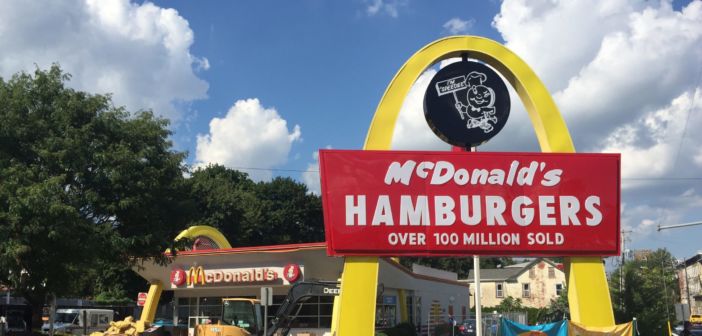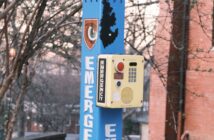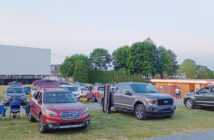In the middle of Wyandotte Street sits an invisible yet inescapable divide — the border of the South Bethlehem Historic District, a barrier between the past and present.
The border marks a portion of the changing city that, in some ways, is frozen in time. However, drivers traveling the bustling street might be surprised to find their windshields blurred with a golden hue — one that is not original to Bethlehem’s cityscape.
“If you come down Wyandotte Street into the historic district of Bethlehem, instead of seeing the glow of Bethlehem’s famous Christmas lights, you see the glowing of McDonald’s neon lights telling visitors how many hamburgers McDonald’s has sold,” said Stephen Antalics, ’52, a South Side native and visiting research scientist at Lehigh. “It’s a retro disaster.”
The South Side Historic District encompasses the area between Wyandotte, Columbia, Hayes and Morton Streets. The Bethlehem McDonald’s was built in 2002 and sits right on the edge of this distinguished area, which was established to embrace the city’s architecture from the late 1800s and early 1900s.
The construction of the McDonald’s is just one battle in Bethlehem’s ongoing war between historic preservation and urban development.
As the city moves forward with revitalization efforts, Becky Bradley, the executive director of the Lehigh Valley Planning Commission, said the community must come to a consensus on its values and priorities.
“The greatest places in the world — the places that are on our bucket lists … tend to be places that evolve well and balance historic character with new development,” Bradley said. “Any time there is change, especially if there hasn’t been a lot of change in that place for a while … you’re going to have a complex community conversation on what that change could be.”
Within the South Side’s historic district is New Street, which according to the South Bethlehem Historic Conservation Committee, has “modest commercial storefront architecture.”
In the eyes of many Bethlehem residents and city officials, that image has been shattered with the development of structures like the New Street parking garage and the Gateway at Greenway Park. Lehigh and St. Luke’s Hospital — both of which are pillars of the community — are tenants of the new office building.
“The scale (of the building) is too big,” said Dana Grubb, a former deputy director of community development. “It should not have been higher than four stories. The parking garage is far too big, and to compound the parking garage issue, the city council had to guarantee the bonds to support the construction of it.”
Although the Bethlehem city council approved the construction, Olga Negrón, a grassroots organizer and member of the council, said the garage is one of many South Side buildings that break historical guidelines and change the footprint of the city. Negrón voted against awarding the project a certificate of appropriateness.
She said the pedestrian bridges that will connect the office building to the garage are another disservice to the community.
“People working in the building (will) have no need to get outside,” she said. “So, how is that going to bring foot traffic to the businesses on the South Side?”
Businesses located in the South Side Historic District must comply with both The Secretary of the Interior’s Standards as well as guidelines implemented by the South Bethlehem Historic Conservation Committee. These guidelines regulate details, from storefronts and masonry to the color of windows and the type of cement businesses can use.
Negrón said business owners in the historic district take pride in upholding historic integrity but might lose morale in the face of unequal treatment.
“It really makes (a small business) feel like an underdog when, here comes a developer — Mr. Big Pocket — breaking all the rules, changing the scenery of what the community has worked for so long and so hard to keep,” Negrón said.
A similar disparity can be found in the development trends on the North and South sides.
Since the North Side was once perceived as more valued and developed, Steve Melnick, a former member of the Bethlehem Economic Development Corporation, said it was held to stricter standards of historic preservation. Despite growth on the South Side, preservation is still held to a looser standard.
He said the contrast between the New Street garage on the South Side and the North Street parking garage, located behind North Bethlehem’s Liberty Center, illustrates a disregard for South Side historic preservation.
“The (garage at) Liberty (Center) blends in with the neighboring architecture — the pediments on the building, all of the accoutrement on the outside — and you wouldn’t necessarily know it’s only a 10- or 15-year-old building,” Melnick said.
Melnick said on the South Side, there’s a stark contradiction. He said the New Street garage does not embody the character of the South Side and instead casts a shadow on the one-, two- and three-story buildings in the surrounding area.
“When you have a historic conservation commission that’s not holding developers’ feet to the fire, and you have city administration that is pushing development from behind the scenes it’s very difficult for a group of citizens to buck the trend and fight back,” Grubb said.
Antalics said these inequalities have much deeper roots and date back to when Bethlehem was separated into boroughs.
Although South Bethlehem was a thriving, robust community with industry, transportation and diversity, Antalics said the Lehigh River served as a social iron curtain that muted the South Side community. It was only the voice of the North Side that was deemed significant.
“The South Side became (the) community of the smokestacks and steeples,” Antalics said. “North Bethlehem residents looked upon South Bethlehem residents as the great unwashed living in shanty town.They were resented. They were unwelcome.”
Negrón said there are only a few South Side residents willing to stand up and make some noise. She said more often than not, members of the overlooked community remain silent because they are afraid of being marginalized.
Despite fear, it is the voice of the South Side that will keep its historic traditions alive. Bradley said having civil conversation is key to upholding the importance and integrity of Bethlehem and the Lehigh Valley as a whole.
“Public dialogue has to play out and people have to be coming from a place of a goodness in order for it all to work,” Bradley said. “I believe what’s happening in Bethlehem and the conversations that I’m hearing coming out of Bethlehem really point to that true and positive civil dialogue, even if it is messy.”






Comment policy
Comments posted to The Brown and White website are reviewed by a moderator before being approved. Incendiary speech or harassing language, including comments targeted at individuals, may be deemed unacceptable and not published. Spam and other soliciting will also be declined.
The Brown and White also reserves the right to not publish entirely anonymous comments.